
Spring City is a city in Sanpete County, Utah, United States. The population was 988 at the 2010 census.

The Beehive House was one of the official residences of Brigham Young, the second president of The Church of Jesus Christ of Latter-day Saints. The Beehive House gets its name from the beehive sculpture atop the house. In 2020, the Beehive House and other historic sites on Temple Square were closed to the public due to the COVID-19 pandemic.

The Utah Territorial Statehouse, officially Territorial Statehouse State Park Museum, is a state park in Fillmore, Utah, preserving the original seat of government for the Utah Territory. Built from 1852 to 1855, the statehouse was initially intended as a larger structure, but only the south wing was completed before the project was abandoned due to lack of federal funding, and the Utah Territorial Legislature met in the building only once before the capital was moved to Salt Lake City in 1856.
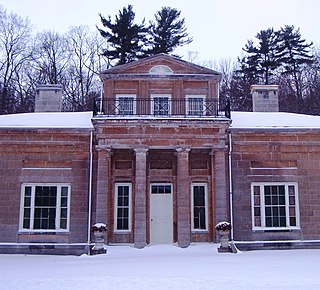
Hyde Hall is a neoclassical country mansion designed by architect Philip Hooker for George Clarke (1768–1835), a wealthy landowner. The house was constructed between 1817 and 1834, and designed with English and American architectural features. It was designated a National Historic Landmark in 1986 for its architecture, and the completeness of its architectural documentary record. It is one of the few surviving works of Philip Hooker, a leading 19th-century American architect.
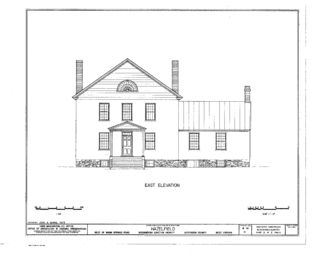
Hazelfield, located near Shenandoah Junction, West Virginia is a historic farm, whose principal residence was built in 1815 for Ann Stephen Dandridge Hunter.

Cedar Lawn, also known as Berry Hill and Poplar Hill, is one of several houses built near Charles Town, West Virginia for members of the Washington family. Cedar Lawn was built in 1825 for John Thornton Augustine Washington, George Washington's grand-nephew. The property was originally part of the Harewood estate belonging to Samuel Washington. The property that eventually became Cedar Lawn was left to Samuel's son, Thornton Washington, who built "Berry Hill", named for his wife's family. Berry Hill was destroyed by fire, and John Thornton Augustine built Cedar Lawn when he inherited.

Harewood is one of several houses in the vicinity of Charles Town, West Virginia built for members of the Washington family.
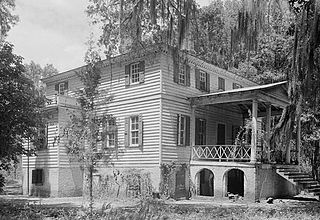
Fairfield Plantation, also known as the Lynch House is a plantation about 5 mi (8 km) east of McClellanville in Charleston County, South Carolina. It is adjacent to the Wedge Plantation and just north of Harrietta Plantation. The plantation house was built around 1730. It is located just off US Highway 17 near the Santee River. It was named to the National Register of Historic Places on September 18, 1975.

The Beaver County Courthouse is a historic building in Beaver, Utah, United States, that is listed on the National Register of Historic Places (NRHP).

Belvidere, also known as Villa Belvidere, is a historic home located in Angelica, near Belmont, Allegany County, New York. Built in 1804 from plans attributed to Benjamin Henry Latrobe, it is an outstanding example of Federal architecture. The mansion was constructed for early settler John Barker Church, former English Member of Parliament and brother-in-law of Alexander Hamilton through his wife Angelica Schuyler Church.

The Waiʻoli Mission District at Hanalei Bay, on Route 560 along the north shore of the island of Kauaʻi, is the site of a historic mission. The first permanent missionaries to the area arrived in 1834, and the district was added to the National Register of Historic Places in 1973.

The Brigham Young Winter Home and Office is a historic residence and museum located in St. George, Utah. Brigham Young was the foremost Mormon pioneer and second president of The Church of Jesus Christ of Latter-day Saints, who led its members to the Utah Territory. As Young grew older, his arthritis precluded him from spending winters in the Salt Lake City region, so a winter home in St. George, in the arid Dixie region of Utah, was built for him. Young seasonally occupied the home and office from 1873 to 1876. The building was eventually deeded to the division of Utah State Parks and Recreation; it is now open as a museum where missionaries of the Church provide guided tours.

Farmington is a house near Charlottesville, in Albemarle County, Virginia, that was greatly expanded by a design by Thomas Jefferson that Jefferson executed while he was President of the United States. The original house was built in the mid-18th century for Francis Jerdone on a 1,753-acre (709 ha) property. Jerdone sold the land and house to George Divers, a friend of Jefferson, in 1785. In 1802, Divers asked Jefferson to design an expansion of the house. The house, since greatly enlarged, is now a clubhouse.
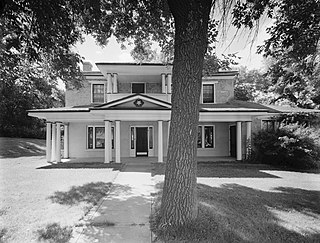
The Hampton's Ford Stage Stop and Barn is a historic district in northeastern Box Elder, Utah, United States, that is listed on the National Register of Historic Places.

The Nelson Wheeler Whipple House is an adobe house in Salt Lake City, Utah, United States built in 1854. Whipple was born in Sanford, New York in 1818, converting to Mormonism in 1844 and moving to Nauvoo, Illinois. After fleeing Nauvoo in 1846, Whipple lived in Garden Grove, Iowa until 1850, when he and his family moved to Salt Lake City. There he acquired two more wives and 17 children, providing wood shingles for the Mormon Tabernacle and keeping a diary that has become an important historical resource.
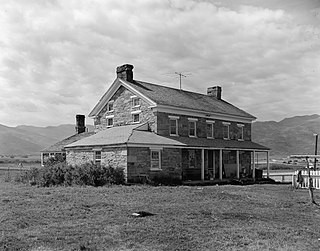
The Kimball Stage Stop was a station on the Overland Trail near Park City, Utah. Located in the Parley's Park valley near U.S. Route 40 at the head of Parley's Canyon, the station was built by William H. Kimball in 1862. Kimball also built a bridge across nearby Kimball Creek. The station's hotel was notable for its dinners, and was visited by Mark Twain, Walt Whitman and Horace Greeley, served at first by Kimball's wife Melissa Burton Coray Kimball, and later by another of Kimball's wives, Martha Vance Kimball,. The station also served the Holladay Stage and the Wells Fargo Express Company.

The Robert D. Covington House was built in 1859 in Washington, Utah. Built for Mormon bishop Robert D. Covington, it was one of the first buildings in Washington and one of the largest in town, furnishing accommodation for visitors that included Brigham Young. The house's second floor originally consisted of one large room, allowing it to be used for assemblies. The second floor has since been subdivided. The Covington family living quarters were on the ground floor and basement.

The Wells Fargo and Company Express Building is a historic commercial building in the ghost town of Silver Reef, Utah, United States, that is listed on the National Register of Historic Places.
Charles Duncan was a Scottish-born stonemason in Utah. He worked on his own and with sons, sometimes known as Charles Duncan and Sons, building numerous stone houses and culverts around Davis County, Utah, and he contributed to the construction of the Salt Lake Temple.




















